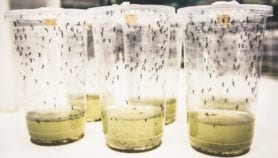Send to a friend
The details you provide on this page will not be used to send unsolicited email, and will not be sold to a 3rd party. See privacy policy.
The chequered history of Bt cotton in India — marked by pest resistance and farmers’ suicides — has polarised opinions over the technology, reports TV Padma.
‘Bt and the beast’ is how cotton scientist Keshav Raj Kranthi refers to the controversial genetically modified cotton so widely planted in India. The ‘beast’ is the American bollworm — a moth larva that devours cotton bolls — while Bt is its nemesis, a protein crystal from the bacterium Bacillus thuringiensis.
Four years after the Indian government allowed farmers to grow Bt cotton, which is genetically modified to contain the Bt toxin, the government’s department of biotechnology and the biotechnology industry say it has led to decreasing use of insecticides and improved yields.
But another picture of India’s Bt saga is emerging — one that points to a pressing need for an enquiry into just how successful genetically modified (GM) technology has been in India.
There are warning signs, for instance, of the bollworm’s resistance to the Bt toxin. The media and nongovernmental organisations point to a worrying rate of suicide among cotton farmers in parts of India, though a direct link between the deaths and Bt cotton has not been established. Further, the monitoring of where and how the cotton is grown is also poor, and a market for legal and illegal, fake and real, Bt cotton has sprung into being.
Given GM’s chequered history in the country, and the polarised opinions of the pro-GM government and industry, and anti-GM activists, a serious, inclusive scientific debate is often impossible.
Chequered history
GM technology arrived in India in 1995, when the US biotech giant Monsanto teamed up with India’s Mahyco to import Bt cotton seeds, which would be crossed and repeatedly backcrossed with local varieties to ensure they could adapt to local conditions. Much of India’s GM debates stems from this point — the technology is seen as an attempt by multinational companies to control India’s agriculture and markets. And poor public access to initial trial data simply worsened matters (see ‘Indian GM research ‘lacks focus and transparency”).
 |
| Scientists have long tried to beat the cotton bollworm larva, the cotton’s nemesis |
| Credit: Peggy Greb, USDA |
The government-funded biotechnology department has consistently promoted GM technology. Nine GM crops involving seven genes are under field tests for insect resistance. Others, such as rice, chickpeas, mustard, aubergine and tobacco, are being developed and tested for improved nutritional content, and resistance to salinity and drought, as well as for creating edible vaccines.
In 2002, India allowed farmers to cultivate Bt cotton — the only GM crop commercially grown in India to date (see ‘India approves cultivation of GM crops’). But by then, a weak regulatory system meant that thousands of illegal Bt cotton seeds had already been sown in Gujarat, western India. This prevented regulators from monitoring Bt cotton plantations, to stop the cross-flow of pollen to non-Bt crops, or to check whether illegally grown Bt cotton respected the refugia standards — cultivation measures that help to offset the build-up of resistance to Bt.
There is now a stand-off between supporters of the technology and activists and who accuse the government and industry of a lack of transparency, which they say has prevented a serious, inclusive scientific debate on the issue.
"With no transparency over GM crops in India, no one, farmers or the state agriculture department, is told anything properly," says Suman Sahai, convenor of the Delhi-based nongovernmental organisation Gene Campaign. But officials from the biotechnology department — who would not be quoted — deny the accusation, saying the process is open.
Suicide and suffering
In 2003, cotton farmers in the southern state of Andhra Pradesh, whose government had aggressively promoted GM technology, suffered severe agricultural and financial losses and many — including entire families — committed suicide. There was no evidence to firmly link the cotton losses to Bt technology, but in May 2005 Andhra Pradesh revoked permission to grow three varieties of Bt cotton.
The repeated failures of cotton crops and another spate of farmers’ suicides in the central state of Maharashtra this year once again put Bt cotton in the spotlight. The crop has failed to meet promises, says Suman Sahai. She says that preliminary analysis of Bt adoption data shows that in Maharashtra’s Vidarbha district, farmers growing Bt cotton accounted for most of the suicides.
"Farmers are bound to react as the hype over increased yields of Bt cotton during trials — claimed as 80 per cent over non-Bt varieties — did not translate into a performance on the ground," biotechnology professor Nandula Raghuram of Delhi’s Indraprastha University, told SciDev.Net.
Signs of resistance
Over the past decade, 21 GM crops involving 42 modified genes have been introduced in 21 countries. Among these, insect resistance has been reported in four crops involving nine plant genes.
   |
| Bt cotton |
| Credit: FAO |
Keshav Raj Kranthi, a senior scientist at the department of biotechnology in the Central Institute of Cotton Research (CICR) based in Nagpur, first drew attention to the inherent problems with Bt cotton in India. In July last year, he reported that toxin levels varied at different stages of plant growth and were lowest in the cotton bolls, where the insect thrived (see ‘Indian GM cotton is ‘inadequate’; enquiry demanded‘).
At an annual meeting of the Indian Academy of Sciences in Indore last month, he revealed the emergence of Bt-resistant bollworms in Indian cotton fields.
The area of Bt cotton plantations in India — 3.44 million hectares — is thirty times larger than it was in 2002, said Mahyco’s managing director Raju Barwale at the meeting. In 2005, planting Bt cotton cut the use of pesticides by 42 per cent, he said. Yield losses went down and net returns increased by US$373 per hectare compared to non-Bt crops.
But a weak regulatory mechanism has led to the emergence of many spurious varieties labelled Bt cotton, as well as unauthorised companies selling the cotton in India, says Kranthi. "There are four kinds of Bt cotton in India," he quips. "Legal, illegal, fake legal and fake illegal."
"On average, 28 per cent of the illegal seed brands are non-Bt," he adds. Among samples collected and tested by CICR, only 26 per cent of the Bt cotton was true first-generation hybrid, while 46 per cent was contaminated with non-Bt cotton.
When proper refugia standards are not followed, contamination can result from the cross-flow of pollen between Bt and non-Bt varieties. The result may be new genetic combinations that fail to express the Bt toxin enough for adequate protection from the bollworm.
Preliminary analysis by CICR in Nagpur, which has monitored resistance to the Bt toxin for the past five years, shows that one in every 667 bollworms in north India, one in every 440 in central India and one in every 400 in south India is resistant to Bt toxin.
More worryingly, it found that some 90 per cent of bollworm larvae leave the field, causing potential contamination. "The bollworm is bound to develop resistance to the Bt toxin in about 10 generations of crop," says Kranthi.
This is despite the Indian government’s recommendation of planting at least 20 per cent of a farm’s cotton acreage with non-Bt cotton as a way to slow down the build-up of Bt resistance.
But Kranthi blames the government for blindly copying the US refugia strategy. In fact the two countries do not even face the same enemy: while the American bollworm Helicoverpa armigera is the most common type of bollworm in India, in the United States its close relatives H. virescens and H. zea are dominant.
An appropriate refugia strategy for India would be to plant five rows of non-GM cotton around Bt cotton, Kranthi says. Other measures could include growing African marigold, which traps the bollworm, in two percent of the fields.
Bollworm blues
In India alone, bollworm causes losses worth US$555 million — despite yearly spraying of insecticides worth almost as much. Cotton, grown by more than four million farmers, occupies only five per cent of the country’s total crop area, yet half the pesticides used in India are applied to combat the bollworm.
   |
| Marigolds are one of the best known natural repellents of the cotton bollworm |
| Credit: Joe Sala, Wikipedia |
Scientists have long struggled to tame the bollworm, which feasts on 181 types of plants, including 69 crop species. As Kranthi points out, it cost US$500 million to develop pesticides against the bollworm, but it took the worm only five years to develop resistance to them.
A single gene mutation is all it takes to make the worm become resistant to an insecticide, he says. "Will the bollworm develop resistance to Bt? Yes. The only question is when."
While Kranthi does not discard the potential of biotechnology, he is concerned about the complacency surrounding the belief that Bt has conquered the bollworm. An apt epitaph for the bollworm is ‘H. armigera: Born 330,000,000 BC, still alive’ he says.
Crucial failing
The government’s efforts to usher in GM crops suffered more setbacks in September, when the supreme court temporarily banned further trials on new GM crops. This followed a public interest petition urging the regulatory system to be foolproof before permitting trials (see ‘Indian Supreme Court bans GM crop trials’).
A month later, angry farmers’ unions burnt trial plots of GM rice in two northern Indian states. The protestors alleged that an Indian company leased the farmers’ plots for trials without explaining the full implications of GM crops to them.
The protestors received unexpected support from rice traders, who are worried that exports of India’s famous aromatic long-grained rice, basmati, could be affected if the fields are contaminated by GM rice.
In the end it seems that the crucial failing of the Indian biotechnology sector is its inability to communicate the pros and cons of the technology in an unbiased manner to the public. Even the country’s biotechnology department implicitly recognises this in its draft development strategy, released in 2005. "Several focused and well-directed measures are needed to achieve public trust and confidence in biotechnology," it says.
Until that is achieved, the battle lines will remain.













